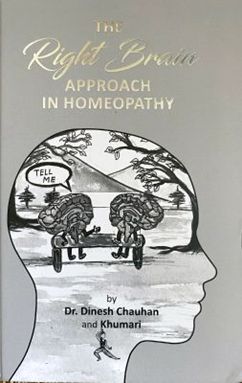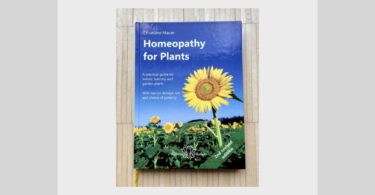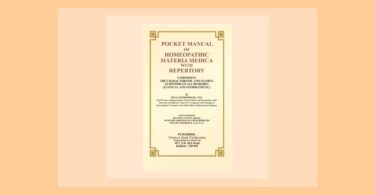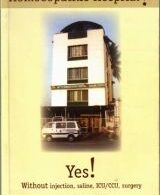Title: The right Brain Approach in Homeopathy
Author: Dr. Dinesh Chauhan MD
Publisher: Philosophia publications, Mumbai, India
ISBN 978-93-5396-848-9
First edition, 2022, hardcover, 331 pages
Reviewer: Vatsala Sperling

In this review, I will introduce you to two new acronyms worth remembering. Planned and intentional or unintentional pursuit of PHEW (Peace, Health, Emotional wellness, and Wealth) is a very human endeavor.
What happens when our best plans fail, and we must deal with DISH (Discord, Ill-health, Setbacks, and Hardships)? What do discord, ill-health, setbacks, and hardships have in common other than annoying us and derailing us from our planned, well-thought-out trajectory?
If this question has ever bothered you and you have been struggling to find the right answer, you have picked the right book to read, The Right Brain Approach in Homeopathy.
As you begin reading, you will see that this book is an outcome of a major setback in the author Dr. Dinesh Chauhan’s life. Actually, several people were directly affected by this setback. Wonderful friends and seminar organizers, Marina Braun, and Sonam Kushner, had done the entire gamut of backstage hard-work required to bring in Dr. Dinesh Chauhan for a four-day seminar in the Fall of 2016.
After completing his seminars in Europe, he was meant to fly to the USA and teach an eager group of students, me included. But then he was struck by ill-health. After receiving critical care in Europe, he cancelled his USA trip and returned home to India.
This health- setback launched him on a path of self-inquiry and research that took him to the next level in his life and he wrote The Right Brain Approach in Homeopathy. Essentially, this book came into being because Dr. Dinesh did not allow DISH to ruin the day for him or, spoil his mood.
He did self-reflection, he researched 17,000 cases from his practice with particular attention to unsuccessful cases, he explored everything he could about the brain, and its functions, and he came up with a way of understanding patients when we get stuck in the case taking process and have no clue how to proceed further for finding a simillimum.
He found a path for getting un-stuck. Jeremy Sherr declares this to be an advanced level book of Dr. Dinesh’s spectacular right brain methodologies. Misha Norland, my teacher, who was also a father-figure and mentor to Dr. Dinseh, observes that Dinesh keeps moving forward and has a knack of taking us with him. Simply put, but very true.
Abdul Hay calls this book a guidebook for practitioner and patient. Marina Braun convinces us that Dinesh’s holistic approach springs from his heart. Van Der Linden Luc calls it a great contribution to homeopathy, and for reading what I call this book, you better read the book and the introduction I wrote.
Dr. Dinesh draws us into the world of right and left brain by using an example of a holistic car with two travelers. The rest of the book is an intricate, practical, and thoughtful manual about how to integrate the left and right brain and arrive at a holistic expression of the brain.
Section one of this book is about an introduction to the scientifically intuitive case witnessing process (SICWP) and how the author has dipped into ancient mythology to make a point that integration of the right and the left is a true integration that leads to wholeness.
This section also gives you a perspective on how Dr. Dinesh’s right brain approach fits in with every other level and style of case taking proposed by masters new and old. Fine details of SICWP are given from pages 53 till 62 and familiarizing yourself thoroughly with these details is a must before you venture any further.
Now, let us see how the right brain approach can fit into our practice. As we start case taking, or case-witnessing, as Dr Dinesh names the process, we get a glimpse of a patient’s life and symptoms, in no particular order, and we must make sense from this data to find a simillimum.
This highly unpredictable real-life phenomenon we face daily as homeopaths, prompted Dr Dinesh to familiarize himself with William Burroughs who used a cut-up technique for writing his books simply because he did not like his books to have a formal, pre-determined structure, a beginning, a middle, and an end.
William Burrough’s style became a touch stone and an inspiration for the author. The idea of dwelling in a place without a formal beginning and an end brought to his mind a sense of continuity, unbroken flow, and an un-hindered multi-dimensional progression….and this was an “Aha” moment for him.
He saw the possibility of creating a space in the case witnessing process where our patient’s logical left brain can be set aside, and they could spontaneously connect with their inner pattern guided by the right brain.
How to set aside the logical left brain? The answer to this question is in section 2 where you will find a splendid menu of 15 different right brain approaches to choose from. At the outset, we also get introduced to Khumari. She is an imagined personality, feminine and playful, an alter-ego, who accompanies the author on his inner journeys and acts as his sidekick, and muse.
If you have reached a point in your practice where you are considering the right brain approach, then read this section as if your life depends on it. Every one of the 15 approaches is a unique method with a step-by-step description. I will include one example here: A world by you, of you, for you: Fairytale method
This method includes the following steps:
- Passive case witnessing process – six questions
- Guided passive case witnessing process– six questions
- Active case witnessing process ––-six questions
- Active-active case witnessing process – understanding the center completely- seven questions
- Active-active case witnessing process- giving the whole to the patient
- Active-active case witnessing process- towards healing- three questions
- Active-active case witnessing process- advice and designer diary
Anyone who has read or heard fairy tales knows that fairy tales, rich with imagination, fantasy, and a wide range of emotions, contain a taste of an alternative reality, and possibility that provides us with a compass in our life’s journey. The ingenuity of Dr. Dinesh is that he has used something very common – fairy tales – for an uncommon purpose, case taking based on a right brain approach.
Similarly, you will find that the other approaches, too, include very common aspects of life, for example, storytelling, autobiography, belief system, imaginary friends, scribbling, abstract art, focusing on illness and profession, use of quotations from relevant sources, self-zine, rapid writing, and internal witnessing method.
I consider what Dr. Dinesh has accomplished as grabbing a mere stone, cutting it at proper angles and turning it in to a gem. He has used very common tools to pull together a whole system of understanding cases that are hard to crack, but once the logical left brain is quieted down, and the right brain is allowed to express un-hindered, the very core of these cases can emerge beautifully.
To test out the efficacy of right brain approaches, Dr. Dinesh has been conducting workshops in various countries, and he also uses it successfully in his own practice, as evidenced by eleven very interesting illustrative cases.
What is most striking about this book is that very adeptly, Dr. Dinesh has used folklore, mythological stories, fairy tales, real-life experiences, deep and meditative insight, and practical tips as a springboard to make his point about why, what, when, where, how, and for whom the right brain approach in case taking can be used. Though you are reading a serious and advanced level academic book, you can get thorough entertainment value as well because you get to read so many stories told adeptly and briefly.
You may ask ‘Isn’t the classical homeopathy style of asking questions enough?’ It is and it is not. You can carry on successfully asking questions in a head-to-foot format, gather PQRS in the mental, emotional, and physical areas, modalities, concomitants, and such, repertorize diligently, prescribe the most highly indicated remedy that pops up on the repertorization chart, and have the patient return for a follow up with no change in his symptoms. He remains a heart-wrenching picture of ill-health.
Then you find yourself asking, ‘where did I miss, what did I do wrong?’ and that is when you begin to experience DISH, the acronym I introduced in the very beginning of this review. As you try to make your way out of DISH, that is when you will find the true purpose and use of Dr. Dinesh’s book. ‘The Right Brain Approach In Homeopathy’.
As students and practitioners, it is our calling to learn from every available source, keep our case taking tools sharp and up to date, and instead of mastering just one technique, and applying it on all our patients whether it suits them or not, we become fluid and use a technique that suits our patients and gives us the best results.
Then only we can say with confidence that we are in a human-centric healing profession. Dr. Dinesh has tested his method in the crucible of his daily practice and summarized his experiences in this book, for your success in cases where you might get stuck. Now it is up to you to use the tools for a better outcome in your own practice.





